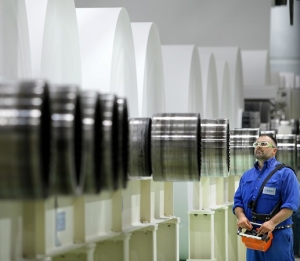
CEPI Says Member Countries' Paper and Board Production Stable, Market Pulp Production Up in 2018 Output of coated mechanical paper remained unchanged whilst production of coated woodfree grades decreased by 7.4%. In contrast with other graphic grades, uncoated mechanical paper saw its production increase by 1.2%. Photo courtesty of Sappi.
Output of coated mechanical paper remained unchanged whilst production of coated woodfree grades decreased by 7.4%. In contrast with other graphic grades, uncoated mechanical paper saw its production increase by 1.2%. Photo courtesty of Sappi.
Feb. 12, 2019 - The Confederation of European Paper Industries (CEPI) reported that its member countries' paper and board production was stable in 2018, compared to the previous year, according to preliminary figures. Total production in 2018 reached 92.2 million tonnes. 2018 saw new capacities coming on stream but also closures. Combined with the upgrade of existing machines, this translated in a net capacity increase of 1.3 million tonnes. CEPI countries in 2018 include: Austria, Belgium, Czech Republic, Finland, France, Germany, Hungary, Italy, Netherlands, Norway, Poland, Portugal, Romania, Slovakia, Slovenia, Spain, Sweden, and the United Kingdom. The production stability observed in Europe contrasts with the reduced global paper and board production — -0.6% in 2018 compared to 2017 — to 417 million tonnes according to very first estimates. This reduction was mainly driven by China, whose production decreased by close to 4%. Paper and board production in Japan, South Korea and the United States has also declined, whilst production in Canada, Russia and several emerging countries (India, Indonesia and Mexico, for instance) increased. Increased production of packaging paper and board offsets the decline in production of graphic papersThe structural divergence in the production trends for graphic grades and packaging grades was confirmed in 2018. The overall production of graphic grades fell by around 3.6%, with the highest decrease of 8.9% recorded in newsprint, used mainly for daily newspapers. The production of graphic papers in other areas — magazines and catalogues, direct mail, directories, etc. — shows very different trends from one grade to the other. Output of coated mechanical paper remained unchanged whilst production of coated woodfree grades decreased by 7.4%. In contrast with other graphic grades, uncoated mechanical paper saw its production increase by 1.2%. The production of uncoated woodfree grades — mainly office paper — is estimated to have decreased by 2.5%. Overall this means that production of coated and uncoated graphic papers decreased respectively by 3.8% and 1.1%. Production of woodfree graphics showed a large decrease of 4.7% whilst output of mechanical graphic papers slightly increased by 0.6%. Paqckaging GradesThe production of packaging grades is estimated to have increased by around 2.4% compared to 2017, despite the ongoing trend towards light-weighting and resource efficiency. Within the packaging grades, case materials — mainly used for transport packaging and corrugated boxes — recorded a 2.7% increase in production. The output of carton board plus other packaging board — small goods packaging or book covers for instance — grew by 2.8%. In contrast, the production of wrapping grades — used for paper bag production — showed a slight decrease of around 0.6% according to preliminary estimates. The share of packaging grades accounted for 52.5% (51.3% in 2017) of the total paper and board production, with graphic grades accounting for 34.8% (36.2% in 2017). CEPI Preliminary Statistics 2018 ReportCEPI's Preliminary Statistics 2018 report (a 2-page PDF with charts and graphs) is available here. The Confederation of European Paper Industries (CEPI) is the pan-European association representing the forest fibre and paper industry. Through its 18 national associations CEPI gathers 495 companies operating more than 900 pulp and paper mills across Europe producing paper, cardboard, pulp and other bio-based products. To learn more, please visit: www.cepi.org. SOURCE: Confederation of European Paper Industries (CEPI) |